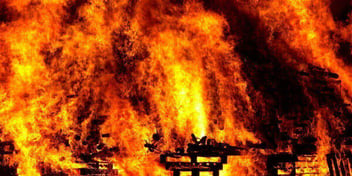We all know that firefighters and other emergency responders arrive on the scene when there’s a fire-related incident, and they have the training to take control of the situation and eliminate the danger. Emergency response plays an enormous role in home safety and workplace safety alike, but there’s another aspect of fire safety that’s equally—if not more—important: fire prevention.
We sat down with Fire Chief James Pantalone of the Howland Fire Department in Ohio to discuss some great tips for everyday fire prevention at home and in the workplace.
Smoke Detectors
Smoke detectors are simple yet effective tools for responding to fires or potential fires in any home or business, but they can’t do their job if you don’t maintain them. “Twice a year, we like to see those batteries changed—in the spring and the fall,” said James.
A convenient reminder to replace the batteries is Daylight Savings Time. Every time you set your clock backward or forward an hour for Daylight Savings Time, change the batteries in all of your smoke detectors. James adds that you should also mark the age of the smoke detectors somewhere on them so you can replace them every ten years.
How many smoke detectors should you have?
“I would certainly recommend that you have at least one smoke detector on every level of your house, apartment, condominium, or wherever you’re living,” said James. And you should place those detectors purposefully to be the most effective. “A smoke detector at the top of a stairwell is the quickest notification of a fire as the smoke comes up the stairwell and acts like a chimney.”
Holiday Decorating
Holidays are hectic enough as it is, so you want to make sure you’re paying close attention to the potential hazards you could be creating while you decorate and prepare for the holidays.
One of the most common hazards we create is with our string lights. “I’ll note the movie

Christmas Vacation,” said James, “where they’ve got all of those plugs all stacked together in the outlet. There’s a big huge pile of them, and they just keep connecting. It’s certainly getting the job done, and it looks like a great idea… Definitely not a great idea.”
He explains that cords and extension cords are a major problem for fire safety, especially during the holiday season. Extension cords are acceptable options in homes as well as workplaces, but they’re meant to be used temporarily rather than as permanent electrical connections. James’s advice is to utilize a power strip with a built-in circuit breaker. Should there be an electrical problem, the in-line circuit breaker will “trip” and therefore immediately stop the power feed. To further reduce fire hazards with your extension cords, be sure that they are not hidden in places that could damage them like under heavy furniture. Placing them under heavy materials can increase the heat resistance and create a hazardous fire condition.
Speaking of Christmas trees, James emphasizes the importance of keeping live trees watered well. “When it dries out, it’s like a tinder box—and yes, the heat from those lights could set that tree on fire.” Luckily, newer technology has helped to reduce the fire hazards. LED string lights give off much less heat than the older styles of string lights that Grandma and Grandpa used on their trees.
Space Heaters
With the approach of the holiday season and the winter weather also comes an increase in the use of space heaters. Whether at home or in the office, heaters create major fire hazards simply because of their nature. James explains that certain types of heaters are equipped with automatic shut-offs in case they are flipped over while powered on, but that over time the shutoff mechanism could stop working. If one of these heaters is knocked over, it could start a fire with the carpet or other nearby combustible objects.
Another common hazard associated with space heaters goes back to the issue of cords. “Do not plug them into extension cords,” James advises. “They can and will overheat those extension cords because they’re just pulling so much amperage through them.” Even when avoiding extension cords, you still need to make sure you’re unplugging those heaters when they’re not being used, especially when everyone leaves for the day. Another great solution is to equip your outlets with timers that are set to shut off at the end of the day, that way powered cords are neutralized when no one’s around to keep an eye on things.
Substance Storage and Disposal
You may be thinking of substances like gasoline and hazardous chemicals when you think about proper storage and disposal of materials. While these certainly cause serious fire hazards, you also need to be aware of the little things like batteries. Take, for example, a 9-volt battery. “You throw it in a garbage can,” said James, “maybe it leans up against an aluminum can. It’ll make a connection on those positive and negative terminals, and you could start a fire with a spark from that 9-volt battery.” His advice is to tape the batteries before disposal so that the terminals can’t come into direct contact with anything that might create that charge.
As far as storage, anything can become a hazard in the wrong conditions. “Notoriously we see people stuffing things into the furnace room,” said James. While it may be important to keep your workplace clean and clutter-free, it’s also important to put things away in a safe place. The furnace room is not a storage closet. Anything that is flammable or combustible, even simple cleaning products, should be stored in a designated safe location.
The Future of Fire Safety
These are all really great tips that you can use today in order to reduce fire hazards and make your workplaces and homes safer for the holidays and all times of the year. But what does the future of fire safety look like from the perspective of a fire chief? “I certainly think it’s moving very fast,” said James. “I notice myself thinking I made a step forward in learning something new about safety, and I found that I’m still five steps behind because there’s so much more out there.” He explains that workplace safety today has made huge leaps even within the past couple of decades. Requirements that didn’t exist in the past now seem like a natural choice on the job and people now seem to be more safety-conscious than ever before.
James is optimistic for the future of fire safety because of the many advances we’ve already seen so far. Gone are the days of sending firefighters into dangerous situations relatively blind and poorly equipped. As new technologies emerge and become integrated into emergency response jobs, the world slowly becomes a safer place for everyone.






Leave a Comment